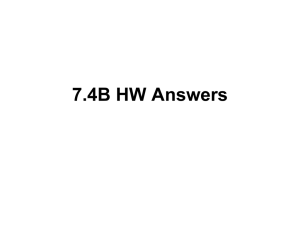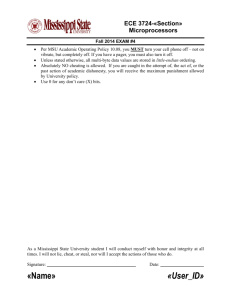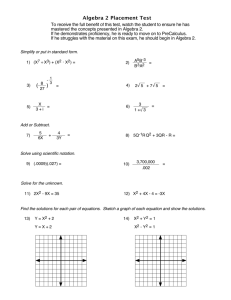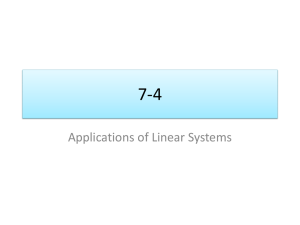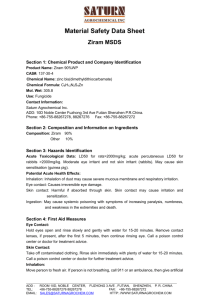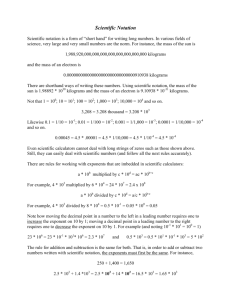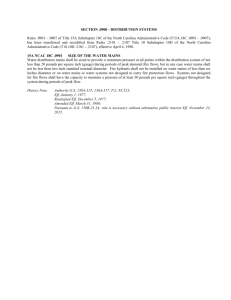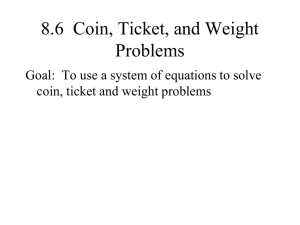Canadian Numbering Plan & Dialling Plan
advertisement
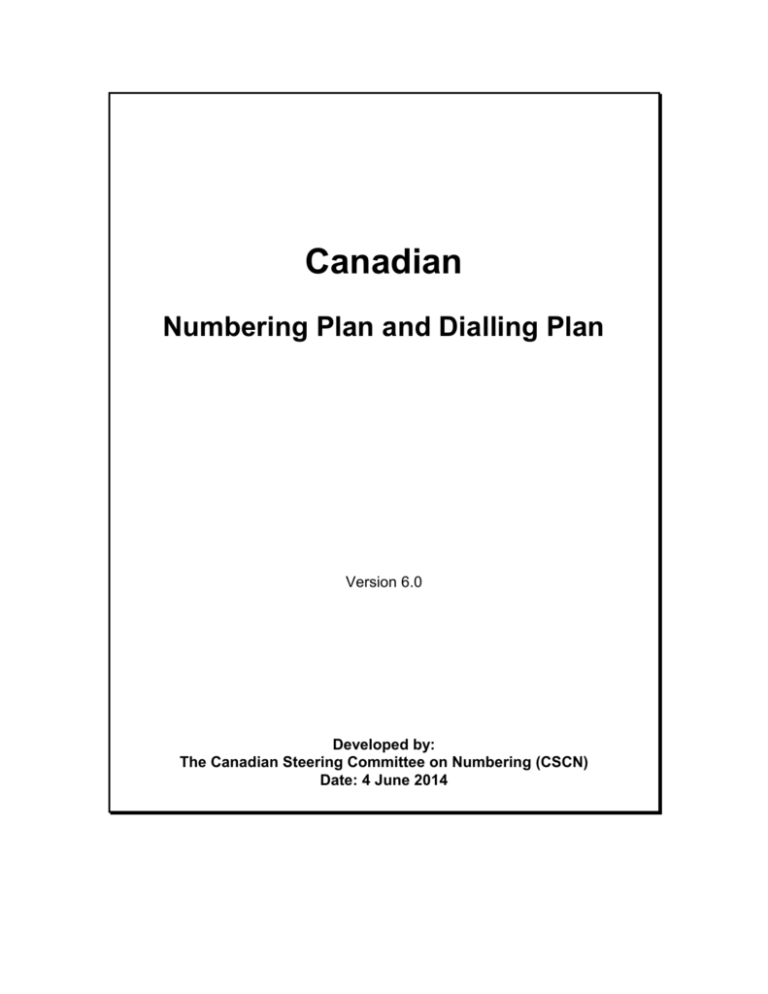
Canadian Numbering Plan and Dialling Plan Version 6.0 Developed by: The Canadian Steering Committee on Numbering (CSCN) Date: 4 June 2014 TABLE OF CONTENTS 1.0 Scope and Overview..................................................................................................1 2.0 Introduction................................................................................................................1 2.1. International Numbering Standards and Conventions ................................................1 3.0 Historical References and Perspectives ....................................................................3 3.1. NANP Responsibilities ...............................................................................................3 3.2. Historical NANP Evolution .........................................................................................6 4.0 Definition of a Telephone Number Used in Canada ...................................................7 4.1 Canadian Telephone Number Format and Values .....................................................7 5.0 The Canadian Dial Plan .............................................................................................7 6.0 Other Codes ..............................................................................................................9 6.1 Prefixes .....................................................................................................................9 6.2 Operator Access Codes ............................................................................................9 6.3 NPA and CO Codes 000-199 ....................................................................................9 6.4 Star Code * .............................................................................................................. 10 6.5 Number Sign # ........................................................................................................ 11 6.6 N11 Codes .............................................................................................................. 11 6.7 Easily Recognizable Codes (ERCs)......................................................................... 12 6.8 Carrier Identification Codes (CICs) .......................................................................... 13 6.9 Carrier Access Codes (CACs) ................................................................................. 13 6.10 Wireless Sector Special Numbering Requirements ................................................. 14 7.0 Acronyms and Abbreviations ................................................................................... 14 8.0 Glossary of Major Terms ......................................................................................... 16 APPENDIX - CANADIAN DIALLING PLAN ......................................................................... 18 Table 1 - Quantity of digits dialled ....................................................................................... 18 Table 2 - Dialling plan in each NPA ..................................................................................... 19 E.164 National Numbering for Canada as Part of Country Code 1 ....... Error! Bookmark not defined. -1- 1.0 Scope and Overview 1 Currently Canada participates in the North American Numbering Plan (NANP) which is the numbering plan used by the 20 nations sharing Country Code 1 under the International Telecommunication Union ITU-T Recommendation E.164, "The international public telecommunication numbering plan" (ITU-T Rec. E.164). This document defines a standard that specifies the format and values of telephone numbers in Canada, called the Canadian Numbering Plan, and the associated Canadian Dialling Plan used on the Canadian portion of the worldwide Public Switched Telephone Network (PSTN). It also identifies other numbering resources that are used in the PSTN, and describes these uses in relation to the Canadian Dialling Plan. The purpose of this document is to consolidate the information contained in other North American and Canadian industry documents into a single reference document for the Canadian Numbering Plan and Dialling Plan. 2.0 Introduction 2.1. International Numbering Standards and Conventions The ITU Telecommunication Standardization Sector (ITU-T) is one of the three Sectors of the International Telecommunication Union, a Specialized Agency of the United Nations with headquarters in Geneva, Switzerland. The ITU-T studies technical, operating and tariff questions, and produces recommendations and other publications that are used to guarantee the interconnectivity and interoperability of networks and enable telecommunication services to be provided worldwide. The ITU-T website is at http://www.itu.int/ITU-T/index.html A Numbering Plan specifies the format and structure of numbers including any segments used for identification, routing, and charging capabilities (e.g., Country Codes, Area Codes and CO Codes used for geographic routing and distance sensitive charges). A Dialling Plan is the combination of digits and additional information that defines the method by which the Numbering Plan is used and may include prefixes, suffixes and additional information supplemental to the Numbering Plan required to complete the call (e.g., dialling the prefixes “0”, “1” and “011” for 1 The NANP is the basic numbering plan for the telecommunications networks in the following 19 countries in Country Code 1: Anguilla, Antigua & Barbuda, Bahamas, Barbados, Bermuda, British Virgin Islands, Canada, Cayman Islands, Dominica, Dominican Republic, Grenada, Jamaica, Montserrat, St. Kitts & Nevis, St. Lucia, St. Vincent & the Grenadines, Trinidad & Tobago, Turks & Caicos Islands, and the United States of America (including Puerto Rico, the U.S. Virgin Islands, Guam, the Commonwealth of the Northern Mariana Islands, and American Samoa). -2- operator assistance, direct dialling within a Country Code, and direct dialling between Country Codes). Canadian telephone numbers generally follow international standards and Canada is compliant with the major recommendations that are contained in ITU-T Rec. E.164 (See section 2.1 for a description of the E.164 Numbering Plan). Participation is essential to allow International Direct Distance Dialling (IDDD). ITU-T Rec. E.164 provides three categories of telephone numbers for international public telecommunications: 1. Geographic Areas 2. Global Services 3. Networks The maximum quantity of digits in the ITU-T Rec. E.164 Numbering Plan is 15. The first field in the ITU-T Rec. E.164 International Numbering Plan is the Country Code which can be from 1 to 3 digits in length. Country Codes may be assigned to Geographic Areas, Global Services or shared among Networks. Canada is part of Country Code 1 (previously called World Zone 1) and shares the single digit Country Code “1” with 19 other nations located primarily in North America. The NANP currently uses 11 digits consisting of a single digit Country Code and a 10-digit National (significant) Number, as indicated below. Structure of the international public telecommunication number according to ITU-T Recommendation E.164 CC NDC 1 to 3 digits SN Max (15-n) digits National (significant) number Max 15 digits International public telecommunication number for geographic areas CC NDC SN n Country Code for geographic areas National Destination Code (optional) Subscriber Number Number of digits in the country code -3- Canadian numbering plan alignment with ITU-T Recommendation E.164 CC = 1 (single digit) NDC = Numbering Plan Area (NPA) Code (3 digits) SN = CO Code plus Line Number (7 digits) n = 1 digit In the NANP, the NPA Code is generally equivalent to the NDC contained in ITU-T Rec. E.164, and the Central Office (CO) Code and Line Number are generally equivalent to the Station Number contained in ITU-T Rec. E.164. The ITU-T Rec. E.164 International Numbering Plan requires that all participating nations ensure that their carriers provision their networks to accommodate up to a maximum of 15 digits. 3.0 Historical References and Perspectives 3.1. NANP Responsibilities AT&T was instrumental in the development and evolution of the numbering portion of the NANP from its inception in 1947 until the breakup of AT&T (Modification of Final Judgment) on January 1, 1984. The NANP was coordinated by Bell Communications Research Corporation (Bellcore) from 1984 until the enactment of the U.S. Telecommunications Act of 1996 (TA-96). In this time period, Bellcore maintained and coordinated the evolution of the NANP by working with telecommunications regulators and industry forums such as the Industry Carriers Compatibility Forum (ICCF) sponsored by the Alliance for Telecommunications Industry Solutions (ATIS). Until 1996, the Industry Numbering Committee (INC) operated as a committee of the ICCF. Since 1996, the INC, operating in cooperation with the NANP area national telecommunications regulators, developed industry consensus guidelines and recommendations for the assignment and administration of NANP numbering resources. These national regulators include the Federal Communications Commission (FCC) in the USA and the Canadian Radiotelevision and Telecommunications Commission (CRTC) in Canada. In Canada, the Canadian Steering Committee on Numbering (CSCN) was established by Industry Canada in 1991 with a mandate to develop strategies and guidelines for the efficient, effective and equitable use of numbering resources in Canada, to provide input and support to Industry Canada on Canadian policies related to numbering, and provide guidance to the Canadian Numbering Administrator (CNA) on the administration of the numbering plan resources in Canada based on agreed guidelines and procedures. The Canadian Incumbent Local Exchange Carriers (ILECs) acted separately as the CO Code Administrators in the NPAs where they operated for many years until the role was transferred to an independent third party administrator in 1999. The Canadian Incumbent Local Exchange Carriers (ILECs) acted collectively -4- under the Trans Canada Telephone System (TCTS), Telecom Canada, and Stentor organizations to perform numbering administration in Canada to about 1994 at which time the role was transferred to Industry Canada. In 1997, the numbering administration role was transferred to the CRTC and, subsequently, in 1999 was transferred to the new independent Canadian Numbering Administrator. In July 1998, under the amended Telecommunications Act, the CRTC was granted authority to administer numbering resources in Canada. Industry Canada remains responsible for coordinating the Canadian position on numbering with the ITU. Section 46.1 through 46.4 of the Telecommunications Act grants the CRTC the authority to administer numbering resources in Canada. 46.1 The Commission may, if it determines that to do so would facilitate the interoperation of Canadian telecommunications networks, (a) administer (i) databases or information, administrative or operational systems related to the functioning of telecommunications networks, or (ii) numbering resources used in the functioning of telecommunications networks, including the portion of the North American Numbering Plan resources that relates to Canadian telecommunications networks; and (b) determine any matter and make any order with respect to the databases, information, administrative or operational systems or numbering resources. 1998, c. 8, s. 6. 46.2 (1) The Commission may, in writing and on specified terms, delegate any of its powers under section 46.1 to any person, including any body created by the Commission for that purpose. (2) For the purposes of sections 62 and 63, a decision of a delegate is deemed to be a decision of the Commission. (3) For greater certainty, a delegation of powers is a decision of the Commission. (4) The Commission may, in writing, revoke a delegation of powers. A revocation is deemed not to be a decision of the Commission. 1998, c. 8, s. 6. 46.3 (1) Subject to subsection (2), a delegate may charge rates for exercising delegated powers. (2) The Commission may regulate the rates charged by a delegate, whether by requiring pre-approval of the rates or otherwise. -5- (3) Notwithstanding the Financial Administration Act, money collected by a delegate is deemed not to be public money. 1998, c. 8, s. 6. 46.4 The Commission may regulate (a) the manner in which any person provides services relating to any of the matters referred to in paragraph 46.1(a); and (b) the rates, whether by requiring pre-approval of the rates or otherwise, charged by the person. 1998, c. 8, s. 6. Currently the CSCN is responsible for addressing Canadian numbering issues and developing number planning and implementation strategies for the Canadian telecommunications industry under CRTC regulatory oversight. The CSCN is an open public forum established as a subtending Working Group of the CRTC Interconnection Steering Committee (CISC). The CISC is a committee comprised of various industry representatives that was initiated to facilitate implementation of Telecom Decision CRTC 97-8, Local Competition, and continues to exist to address various telecommunications industry issues. For further information, see the CSCN Adjunct to the CISC Administrative Guidelines which is available at http://www.crtc.gc.ca/cisc/eng/cisf3fg.htm. In Country Code 1 the NANP numbering resources at the NPA level are administered by the NANP Administration (NANPA), which is contracted by the U.S. federal government to a neutral third party. In Canada, NANP numbering resources used in or assigned to Canada, including NPAs and other numbering resources, are administered by the CNA, which is a neutral third party operating under CRTC regulatory oversight under a contract with the Canadian Numbering Administration Consortium (CNAC). The CNAC is a company that was incorporated on June 5, 1998 under the Canada Business Corporations Act and operates under the regulatory oversight of the CRTC. The primary role of the CNAC is to administer the selection and funding of a neutral administrator who performs the functions of Canadian numbering administration for the Canadian telecommunications industry. In addition, the CNAC pays the Canadian share of the costs of the North American Numbering Plan Administration (NANPA). The cost of performing this function is funded by Canadian telecommunications service providers (TSPs) who benefit from numbering resources within Canada. For additional information see http://www.cnac.ca/cnac/cna_consortium.htm. -6- 3.2. Historical NANP Evolution 1947: Initial NANP developed 2 NANP format: N (0 or 1) X – NNX – XXXX where N = 2 to 9 and X = 0 to 9. Initially the NN digits in the NNX portion of a NANP number had "exchange" names whose first two letters corresponded to letters associated with the NN digits on North American telephone dials, e.g. 23 could be BEechwood, BElmont, or CEdar. 7-digit NNX-XXXX numbers were represented as 2-letter + 5-digit numbers (2L-5D), so that 736-5000 could be expressed as PE.6-5000 or Pennsylvania 6-5000. The use of the 2L-5D representation was phased out following the introduction of All Number Calling in 1959. 1973 Initial introduction of Interchangeable CO Codes NANP format: N (0 or 1)2X – NXX – XXXX 1995: Interchangeable NPA codes implemented NANP format: NXX – NXX – XXXX The theoretical capacity of the current 10-digit NANP format is 6.4 billion numbers (i.e., 800 Area Codes X 800 CO Codes X 10,000 Telephone Numbers). At the time this version of the Guideline was developed, the NANPA 2009 Annual Report forecast that the NANP would exhaust beyond 2039. See the NANPA website at: www.nanpa.com, for additional information. In the future it is uncertain how the NANP format will evolve to meet the expected increased demand for telephone numbers. In recent years the INC and the CSCN have recommended to the governments of the nations participating in the NANP that the NANP be expanded from 10 to 12 digits when additional numbering resources are required. The INC and CSCN have recommended that future expansion of the NANP be done by adding a new 4th digit at the end of the NPA and a new 5th digit at the beginning of the CO Code. The new NANP format would be: NXXX-XNXX-XXXX. Expansion would be preceded by the implementation of 10-digit dialling for both local and toll calls (elimination of 1+ for toll). At this time, the governments of Canada and the other 19 nations in the NANP have not yet agreed on an expansion plan; however it is expected that the recommendation to expand from 10 to 12 digits will be approved should the need arise. For additional information see the CSCN Report to CRTC on NANP Expansion CNRE008A.doc which is available at http://www.crtc.gc.ca/cisc/eng/cisf3ff.htm. 2 The use of the parentheses in this instance indicates that the central digit of the Area Code could only be "1" or "0". -7- 4.0 Definition of a Telephone Number Used in Canada 4.1 Canadian Telephone Number Format and Values The numbering plan used in Canada and the other 19 nations served by Country Code 1 is known as the NANP. A Canadian telephone number consists of the Country Code 1 plus a 10-digit NANP telephone number. Current NANP telephone numbers are ten digit numbers that consist of the following three basic parts: a) A 3-digit Numbering Plan Area (NPA) code, commonly called the Area Code. b) A 3-digit Central Office (CO) Code, sometimes referred to as the NXX code. The term Central Office (CO) Code is used in this document because of its long standing use and because the NXX format is now used for both CO Codes and NPA Codes. c) A 4-digit Line Number sometimes referred to as a station number. The current format of a ten digit NANP Number is NXX-NXX-XXXX where N = digits 2 through 9, and X = any digit of 0 through 9. The digit positions in the NANP format, excluding the Country Code, can be identified by alphabetical characters using the following format ABC-DEF-GHIJ, where ABC is the NPA, DEF is the CO Code, and GHIJ is the Line Number. Therefore: A complete Canadian telephone number is an eleven digit number that contains the Country Code “1” plus the 10-digit NANP telephone number. When written or printed, the three groups of digits comprising the 10-digit NANP number should be visually separated by dashes, spaces or periods in accordance with ITU-T Recommendation E.123 “Notation for national and international telephone numbers, e-mail addresses and Web addresses” to make them easier to recognize and remember (e.g., NXX NXX-XXXX). When a Canadian telephone number is written or printed as an international number, the NANP number should be prefixed by "+1" and a space (e.g., +1 NXX NXX-XXXX). 5.0 The Canadian Dial Plan In Canada, there is no single Dial Plan that applies universally in all areas. In most locations (i.e., Numbering Plan Areas) where a single NPA code is in use, local calling within a defined geographic area called the Local Calling Area (LCA), can generally be done by dialling only the last 7 digits (7D) of the NANP number (i.e., the CO Code and Line Number). In those locations some telecommunications service providers may also permit callers to dial 10 digits (10D) for local calls on a permissive dialling basis. In some wireless networks, 1+ 10 digit dialling may also be allowed on a permissive basis for local calls in addition to standard 10 digit local dialling. In locations where overlay NPA Codes -8- have been implemented (i.e., more than one NPA Code is in use within a Numbering Plan Area) or where local calling crosses an NPA boundary, local calling generally requires dialling the full 10-digit NANP number (i.e., the NPA, CO Code and Line Number). In some locations local calls across an NPA boundary may be dialled using only the last 7 digits of the NANP number (i.e., the CO Code and Line Number); however this requires CRTC approval and special CO Code assignment practices to ensure that dialling conflicts are not created by assigning two identical CO Codes in different NPA Codes in the LCAs. Long distance calling to NANP locations outside the originating caller’s local calling area requires dialling the prefix 1 plus the 10-digit NANP number (1+10D) for direct dialled calls, or dialling the prefix 0 plus the 10-digit NANP number (0+10D) for operator assisted calls (see section 6.1 for further information regarding prefix dialling requirements). For long distance calling outside Country Code 1, the Dial Plan is the appropriate international calling prefix (e.g., 01 and 011) plus the international telephone number. See the Appendix “Canadian Dialling Plan” for additional information. In the late 1990s, the INC and CSCN examined the need for a Uniform Dialling Plan (UDP) throughout the NANP area. After consideration of many options, the INC and CSCN both concluded that adoption of a UDP would be beneficial for the industry and customers. The INC and CSCN recommended to the NANP area nations’ regulators that a Uniform Dialling Plan be adopted. The benefits of a Uniform Dialling Plan include reduced customer confusion, particularly in today’s mobile society, and support for a consistent, fair and equitable competitive environment. Specifically the INC and CSCN recommended that 10digit dialling be adopted as the UDP for both Local and Toll (i.e., long distance) calling. The INC and CSCN noted that implementation of the recommendation requires regulatory approval and resolution of the need for “1+” as a toll indicator. In Canada, some carriers supported the implementation of a toll warning indicator tone when additional toll charges for long distance calls would apply. The INC suggested that migration to the UDP should begin by first adopting the following dialling arrangements as interim steps: 1. 10-digit local dialling within the Home NPA with 1+ 10-digit dialling on a permissive basis 2. 10-digit local dialling to a Foreign NPA with 1+10-digit dialling on a permissive basis See the Glossary for definitions of Home NPA and Foreign NPA. In conjunction with the migration to the UDP, the INC recommended that the industry address the need for the continued use of a toll indicator. The successful completion of the above steps would allow for the implementation of the 10-digit dialling UDP throughout the NANP area. All other numbers used by telephone systems fall in the category of prefixes or access codes. All of the numbers, access codes and prefixes comprise the Canadian Dialling Plan found in the Appendix. -9- 6.0 Other Codes The industry has always employed other codes to access certain capabilities or call types. 6.1 Prefixes The most commonly used prefixes are the digit 1 preceding a sent paid toll call, and the digit 0 which precedes an operator handled toll call. The current list of commonly used prefixes is shown below. Prefixes are usually deleted or used in the originating switch before the NANP number digits are used to route the call to its final destination. Prefix 0+ NANP 10-digit Number 01+ International Number 011 + International Number 1+ NANP 10-digit Number Use of Code Person Paid Collect Special (PPCS) Call International PPCS Call International Station to Station Sent Paid (SSSP) Call Toll Access for SSSP Calls The wireless telephone industry does not always use standard NANP wireline prefixes or access codes. For example, in some wireless networks based on the Global System for Mobile communications standard (GSM), the "+" character dialled before the Country Code and National Number provides uniform dialling for local, toll and international calls, and avoids the need for country-dependent prefixes. 6.2 Operator Access Codes Two special codes can be dialled to access operators, as per the table below: Operator Access Code 0 00 6.3 Use of Code Telephone Company Operator Long Distance Carrier Operator NPA and CO Codes 000-199 Using the values 0 and 1 in the “A” or “D” digit positions of a NANP number would create the NPA and CO Codes in the series 000-199. These codes are not part of the currently defined NANP format for either the NPA or CO Code portions of a NANP number, and therefore are not publicly diallable or routable NANP telephone numbers (as the NPA and CO Code format is NXX where N= 2 to 9 and X = 0-9, the 0XX and 1XX NPA and CO Codes are not NANP numbers). 000-199 were excluded from the original NANP format and this exclusion has continued to date. - 10 - However, the NANP-wide telephone industry uses these codes for various networking and operational purposes including, but not limited to, Test Codes, Inward Operator Codes, Special Billing Numbers, Revenue Accounting Office (RAO) Credit Card Numbers and special routing of calls. Various switching systems have employed software checks that block calls to and from numbers with the codes 000-199. These software checks were installed to minimize fraud. In addition, Operator Services switching systems have software to validate credit card calls that utilize these codes. Numbers utilizing the codes 000-199 are not customer diallable. 6.4 Star Code * The star code* is standardized within the PSTN and used for special dialling and 3 communications purposes. It is important that consistent terminology be known and used when referring to this character. The * should be called the “star” and not “asterisk”. Currently, the * character has the following general applications: The standard use of the star (*) is as a prefix when dialling a Vertical Service Code (VSC). VSCs are customer-dialled codes that provide access to features and services provided by local exchange carriers, interexchange carriers, commercial mobile radio service (CMRS), etc. Services invoked by VSCs include call forwarding, automatic callback, customer originated trace, and many others. The format of a VSC is *XX or *2XX (Dual Tone Multi Frequency DTMF telephone) and 11XX or 112XX (rotary dial telephone). For example, call forwarding is activated by dialling *72 or 1172. VSCs are assigned according to guidelines proposed by the CSCN and approved by the CRTC, and are listed on the CNA web site at www.cnac.ca. Currently there is some inconsistency in the use of VSCs for specific features or services in different carrier networks. In this application, the * indicates to the switching system that the digits following specify a certain desired feature or service. Access to vertical services from rotary dial telephones can be accomplished by dialling the digits “11” prior to the XX or 2XX digits. The local serving switch translates the “11” to simulate the star key in stored program controlled switches. Vertical Service Code Format *XX (*2XX) 11XX (112XX) Use of Code Vertical Service Code Access Vertical Service Code Alternate (Permissive) Access Vertical Service Codes are NANP numbering resources. They are administered by NANPA. The current agreed allocations for VSCs are available at the web site: http://www.nanpa.com/ 3 AT&T Technical Advisory #3, NPL 81-09-27, Issue 2, December 1, 1981 - 11 - Once a connection is made via the PSTN, the star code * may be used for secondary signaling purposes with equipment attached to the PSTN. For example, the * code may be used within a carrier’s network to provide an error correcting function for secondary dialling by customers of various series of digits on a sequential basis in response to prompting from a network element. 6.5 Number Sign # The number sign # code is standardized within the PSTN and used for special dialling and communications purposes. It is important that consistent terminology be known and used when referring to this character. The # should be called the “number sign” and not “pound”, “octothorpe”, “hash” or “sharp”. Currently, the # character has the following general application. The standard use of the number sign # is as an end-of-dialling indicator or conclude the present action and proceed to the next action indicator. This endof-dialling use exists today, and avoids the need for invoking a timing period in certain types of switching systems. The conclude-and-proceed use also occurs in some telephone credit card service applications where the customer wants to indicate that the present call is over and a new call is about to be placed (e.g., sequence calling). Another historical use of the number sign # was as the first character when dialling a call that is a wideband or other data call requiring special treatment. In certain types of data calls, both an initial and a concluding # may be required. This was only used in networks with Multi-Frequency (MF) signaling. There are also some non-standard uses of the # sign for Personal Identification Number (PIN) calling features. The # sign is also used in ancillary equipment attached to the PSTN. An example of this is equipment used to provide voice mail services. 6.6 N11 Codes N11 Codes are assigned by the CRTC in Canada and by the FCC in the United States. In Canada, the CRTC assigns the N11 codes for specific applications in accordance with criteria established by the CRTC in Telecom Decision CRTC 2001-475 Allocation of 3 digit dialling for public information and referral services. Geographic NPAs and CO Codes in format N11 are not assignable in Country Code 1 to avoid causing customer confusion and network routing difficulties. Canadian N11 Service Codes N11 Code 211 311 4 Telecom Decision CRTC 2001-475 Use of Code Community Information4 Non-Emergency Municipal Government Services5 - 12 - N11 Code 411 511 611 711 811 911 6.7 Use of Code Directory Assistance Weather & Traveller Information6 Repair Service Access to Message Relay Service (MRS) by the deaf7 Non-urgent Health Teletriage Services8 Emergency Easily Recognizable Codes (ERCs) Easily Recognizable Codes (ERCs) are NPA Codes that due to their unique, recognizable digit pattern (e.g., common 'B' and 'C' digit; codes with the same second and third digits) convey certain unique knowledge regarding a call to a telephone number other than the number being dialled (e.g., 800+). ERCs include N00 NPA Codes, codes for other special services, e.g. toll-free service, and N11 Codes. N11 Codes are described in section 6.6 above. .N00 NPA Codes and toll-free codes are allocated by the Alliance for Telecommunications Industry Solutions’ (ATIS) Industry Numbering Committee (INC). N00 NPA Codes ERC 200 300 400 500 600 700 800 900 Status or Use of Code Unassigned Unassigned Unassigned Personal Communications Services – Note 1 Canadian Non-Geographic Services IXC Intra-Network Services – Note 2 Toll Free Services Pay-Per-Call Information Services Note 1: NPA 533 is also assigned for Personal Communications Services growth. NPAs 522, 544, 566, 577 and 588 are reserved for future PCS expansion. Note 2: NPA 700 numbers can be used independently by each Interexchange Carrier (IXC) for applications and customers on its own network. Therefore, different customers on different IXC networks may be assigned the same NPA 700 number. Toll-free Service Codes ERC 800 888 877 866 855 844 5 6 7 8 Status In service In service In service In service In service In service Telecom Decision CRTC 2004-71 Telecom Decision CRTC 2006-44 See CRTC letter dated August 4, 1993 from the CRTC Secretary General to the Chairman of the CSCN. Telecom Decision CRTC 2005-39 - 13 - ERC 833 822 880 881 882 883 884 885 886 887 889 Status Allocated but not in service Allocated but not in service Reserved - set aside for next series of toll free codes Reserved - set aside for next series of toll free codes Reserved - set aside for next series of toll free codes Reserved - set aside for next series of toll free codes Reserved - set aside for next series of toll free codes Reserved - set aside for next series of toll free codes Reserved - set aside for next series of toll free codes Reserved - set aside for next series of toll free codes Reserved - set aside for next series of toll free codes In addition to the ERCs identified above, there is an additional quantity of ERCs that have been assigned or reserved for Canada’s future use. At the suggestion of the CSCN and with CRTC approval and direction, a pool of six (6) NPA Codes was reserved by the NANPA for future use as Canadian Non-Geographic Relief NPA Codes. These NPA Codes are subject to assignment for use in Canada based upon the Canadian Adjunct to the INC NPA Allocation Plan and Assignment Guidelines. Canadian Non-Geographic NPA Codes (ERCs) ERC 600 622 633 644 655 677 688 6.8 Status In service Reserved Reserved Reserved Reserved Reserved Reserved Carrier Identification Codes (CICs) CICs are 4 digit codes used mainly to route long-distance calls to a customer's IXC of choice. The CIC is associated with the customer's line for 1+ and 0+ calls. A customer may also dial the CIC as part of a Carrier Access Code number. In Canada, the CNA, in cooperation with NANPA, conducts the assignment of CICs to IXCs, Switchless Resellers and LECs. 6.9 Carrier Access Codes (CACs) In order to select an IXC for a call, customers can dial an access code that contains a CIC. The format of this CAC is either 101XXXX or 950XXXX, where the XXXX is the CIC. CAC 101XXXX is used as a prefix to the normal dialling sequence for a toll call. CAC 950XXXX requires secondary dialling that includes an authorization code and the called number. - 14 - Carrier Access Code 101XXXX 950XXXX 6.10 Use of Code Carrier Access Code (CAC), Feature Group “D” Carrier Access Code (CAC), Feature Group “B” Wireless Sector Special Numbering Requirements The wireless telephone industry also has other numbering requirements, separate from the number associated with the wireless subscriber. Most of these requirements are necessitated by wireless roaming and access to emergency services via dialling 9-1-1. Acronym Description Format Comments ESRD Emergency Service Routing Digit 10-digit NANP # in format NXXNXX-XXXX IMSI International Mobile Station Identity NXX-XXXXXXXXXXXX IRM International Roaming Mobile Identification Number Mobile Directory Number Mobile Identification Number 1/0-XXX-XXXXXXX Identifies the cell site and sector from which a Wireless E9-1-1 call originates. In Canada, in each geographic NPA, the 511XXXX and 211-XXXX series of telephone numbers have been allocated for use as ESRDs. A non-diallable number that uniquely identifies a mobile station used in wireless networks that conform to ITU-T Recommendation E.212. An IMSI consists of a Mobile Country Code (3 digits) + Mobile Network Code (3 digits) + Mobile Station Identification Number (9 digits in North America). A 10-digit MIN that is a transitional terminal identifier for international CMRS Roaming. Mobile Station Identity 10 or 15 digits MDN MIN MSID 7.0 NPA-NXX-XXXX Wireless subscriber’s 10-digit NANP telephone number. NXXNXX-XXXX A non-diallable number that uniquely identifies a mobile station used with most wireless networks based on CDMA (Code Division Multiple Access), TDMA (Time Division Multiple Access) and AMPS (Advanced Mobile Phone System). A MIN consists of a MIN Block Identifier (6 digits) + Mobile Subscriber Number (4 digits). A non-diallable number used to uniquely identify a mobile station; the MSID is either a MIN or an IMSI. Acronyms and Abbreviations 2L-5D AMPS 2 Letters + 5 Digits Telephone numbers Advanced Mobile Phone System - 15 - AT&T ATIS CAC CC CDMA CIC CISC CMRS CNA CNAC CO Code CRTC CSCN DDD DTMF ERC ESRD FCC GSM ICCF IDDD IMSI INC IRM ITU ITU-T IX IXC LCA MDN MF MIN MRS MSID NANP NANPA NDC NPA PIN PPCS PSTN RAO SN SSSP TDMA UDP USITA USTA VSC American Telephone and Telegraph Alliance for Telecommunications Industry Solutions Carrier Access Code Country Code Code Division Multiple Access Carrier Identification Code CRTC Interconnection Steering Committee Commercial Mobile Radio Services Canadian Numbering Administrator Canadian Numbering Administration Consortium Central Office Code (NXX) Canadian Radio-television and Telecommunications Commission Canadian Steering Committee on Numbering Direct Distance Dialling Dual Tone Multi Frequency Easily Recognizable Code Emergency Service Routing Digit United States Federal Communications Commission Global System for Mobile communications standard; originally from Groupe Spécial Mobile Industry Carriers Compatibility Forum International Direct Distance Dialling International Mobile Station Identity ATIS-sponsored Industry Numbering Committee International Roaming Mobile Identification Number International Telecommunication Union ITU Telecommunication Standardization Sector Interexchange Interexchange Carrier Local Calling Area Mobile Directory Number Multi-Frequency Mobile Identification Number Message Relay Service Mobile Station Identity North American Numbering Plan North American Numbering Plan Administration National Destination Code Numbering Plan Area (Area Code) Personal Identification Number Person to Person, Collect and Special Public Switched Telephone Network Revenue Accounting Office Station Number Station to Station Sent Paid Time Division Multiple Access Uniform Dialling Plan United States Independent Telephone Association United States Telecom Association Vertical Service Code - 16 - 8.0 Glossary of Major Terms Central Office Code (CO Code) Foreign NPA Foreign NPA Code Home NPA Home NPA Code The D-E-F digits of the 10-digit NANP number in a telephone number. Central Office Codes (also sometimes referred to as the NXX) are in the format NXX, where N is a number from 2 to 9 and X is a number from 0 to 9. Foreign NPA means a NANP geographic Numbering Plan Area (NPA) that is any NANP NPA other than the Home NPA. See Home NPA definition. Foreign NPA Code means, depending on the context in which it is used, either a) a geographic NPA Code that serves a Foreign Numbering Plan Area (NPA) (Canadian NPA Relief Planning Guideline and Canadian Central Office Code (NXX) Assignment Guideline), or b) a geographic NPA Code that is not the NPA Code of the calling party’s 10-digit telephone number (Canadian Numbering Plan & Dialling Plan). See Home NPA Code. Home NPA Code means, depending on the context in which it is used, either a) a geographic NPA Code(s) that serves an exhausting Numbering Plan Area that requires relief (Canadian NPA Relief Planning Guideline), or b) a geographic NPA Code serving the Home NPA (Canadian Central Office Code (NXX) Assignment Guideline), or c) the geographic NPA Code of the calling party’s 10-digit telephone number, or, when roaming, a geographic NPA Code associated with the NPA from which a wireless calling party is originating a call when the call is originated outside the NPA served by the geographic NPA Code of the caller’s 10-digit telephone number (Canadian Numbering Plan & Dialling Plan). See Foreign NPA Code. Home NPA Code means, depending on the context in which it is used, either a) a geographic NPA Code(s) that serves an exhausting Numbering Plan Area that requires relief (Canadian NPA Relief Planning Guideline), or b) a geographic NPA Code serving the Home NPA (Canadian Central Office Code (NXX) Assignment Guideline), or c) the geographic NPA Code of the calling party’s 10-digit telephone number, or, when roaming, a geographic NPA Code associated with the NPA from which a wireless calling party is originating a call when the call is originated outside the NPA served by the geographic NPA Code of the caller’s 10-digit telephone number (Canadian Numbering Plan & Dialling Plan). See Foreign NPA Code. - 17 - North American Numbering Plan (NANP) Numbering Plan Area (NPA) NPA Code Public Switched Telephone Network The North American Numbering Plan is the basic numbering plan for the Public Switched Telephone Network in the following 20 countries in Country Code 1 (formerly known as World Zone 1): Anguilla, Antigua & Barbuda, Bahamas, Barbados, Bermuda, British Virgin Islands, Canada, Cayman Islands, Dominica, Dominican Republic, Grenada, Jamaica, Montserrat, Sint Maarten, St. Kitts & Nevis, St. Lucia, St. Vincent & the Grenadines, Trinidad & Tobago, Turks & Caicos Islands, and the United States (including Puerto Rico, the U.S. Virgin Islands, Guam, the Commonwealth of the Northern Mariana Islands and American Samoa). The format of the NANP follows International Telecommunications Union (ITU) standards as detailed in Recommendation E.164, or as amended. The NANP format currently consists of 10-digits in the format NXXNXX-XXXX where N = 2 to 9 and X = 0 to 9. The digit positions in the NANP may be identified by alphabetical characters using the following format ABC-DEF-GHIJ where ABC is the Area Code or Numbering Plan Area (NPA), DEF is the Central Office Code or NXX (CO Code), and GHIJ is the Line Number. A Numbering Plan Area (NPA) is a discrete geographic area, within the area served by the NANP, to which one or more Geographic NPA Codes may be assigned. An NPA Code (also called an area code) is a three-digit code that occupies the A, B, and C positions in the ten-digit NANP format. NPA Codes are of the form NXX, where N represents any digit 2-9 and X represents any digit 0-9. In the NANP, NPA Codes are classified as either geographic or non-geographic as follows: 1) A Geographic NPA Code is an NPA Code which is used to serve a discrete Numbering Plan Area (NPA) within the NANP. 2) A Non-Geographic NPA Code is an NPA Code that does not correspond to a discrete Numbering Plan Area (NPA) within the NANP, but which is instead assigned for a service with attributes, functionalities or requirements that transcend specific individual Geographic NPA boundaries. For example, Geographic NPA Code 204 serves the Numbering Plan Area comprised of the province of Manitoba, whereas Nongeographic NPA Code 800 can be used to provide toll-free services throughout the entire NANP area. The Public Switched Telephone Network is composed of all transmission and switching facilities and signal processors supplied and operated by all telecommunications common carriers for use by the public. Every station on the PSTN is capable of being accessed from every other station on the PSTN via the use of NANP numbers. - 18 - APPENDIX - CANADIAN DIALLING PLAN Table 1 - Quantity of digits dialled QUANTITY OF DIGITS DIALLED FORMAT CALL TYPE No digits Seizure (off hook) wireline only Hot Line, Warm Line One digit 0 Local Operator Two digits 00 IXC Operator Three digits N11 *XX Service Codes Vertical Service Codes Four digits 11XX Vertical Service from Dial Pulse phone (also works on DTMF phones) Vertical Service Codes *XXX Seven digits NXX-XXXX Ten digits NXX-NXX-XXXX Eleven digits 1 NXX-NXX-XXXX 0 NXX-NXX-XXXX Greater than eleven digits 01 + CC + NDC + number where CC = Country Code and NDC = National Destination Code (City Code) 011 + CC + NDC + Number where CC = Country Code and NDC = National Destination Code (City Code) Local call, where 7digit local dialling is in effect Local call, where 10digit local dialling is required, or offered on a permissive basis where 7-digit local dialling is in effect. SSSP call to another NANP location PPCS call to another NANP location International PPCS call International SSSP call COMMENTS Automatic connection to predetermined location (e.g., to local telecommunications service provider operator or business office) Connection to local Telecommunications Service Provider’s operator Connection to originating customer's IXC’s operator Connection to special services Activation of service, acknowledgment tone is returned to customer and dial tone is returned. Activation of service, acknowledgment tone is returned to customer and dial tone is returned. Activation of service, acknowledgment tone is returned to customer and dial tone is returned. Call completion Call completion Call completion Call completion Call completion Note: The quantity of digits can be from 12 to 15 digits plus the Access Code. Call Completion Note: These calls can be from 12 to 15 digits plus the Access Code. - 19 - Table 2 - Dialling plan in each NPA CANADIAN DIALLING PLAN 4 April 2014 CURRENT DIALLING PLAN STANDARD DIALLING PLAN NPA PROVINCE or TERRITORY LOCATION HNPA LOCAL HNPA TOLL FNPA LOCAL FNPA TOLL OPERATOR ASSISTED 10D 1+10D 10D 1+10D 0+10D 10D 1+10D 10D 1+10D 0+10D 204 Manitoba 226 Ontario Manitoba (province-wide) – overlay area 204/431 SW Ontario (Windsor, London, Waterloo) overlay area 226/519 236 British Columbia British Columbia (province-wide) – overlay area 236/250/604/778 10D 1+10D 10D 1+10D 0+10D 249 Ontario NE Ontario – overlay area 249/705 10D 1+10D 10D 1+10D 0+10D 250 British Columbia 10D 1+10D 10D 1+10D 0+10D 289 Ontario 10D 1+10D 10D 1+10D 0+10D 306 Saskatchewan 10D 1+10D 10D 1+10D 0+10D 343 Ontario 10D 1+10D 10D 1+10D 0+10D 365 Ontario Vancouver Island & Mainland excl. Lower Mainland (Note A) – overlaid by 236/778 S Ontario surrounding 416/437/647 – overlay area 289/365/905 Saskatchewan (province-wide) – overlay area 306/639 E Ontario (Ottawa) (See Note B) – overlay area 343/613 S Ontario surrounding 416/437/647 – overlay area 289/365/905 10D 1+10D 10D 1+10D 0+10D 403 Alberta S Alberta (Calgary) – overlay area 403/587 10D 1+10D 10D 1+10D 0+10D 416 Ontario 10D 1+10D 10D 1+10D 0+10D 418 Québec Toronto – overlay area 416/437/647 NE Québec (Québec City) – overlay area 418/581 10D 1+10D 10D 1+10D 0+10D - 20 - CANADIAN DIALLING PLAN 4 April 2014 CURRENT DIALLING PLAN STANDARD DIALLING PLAN NPA PROVINCE or TERRITORY LOCATION HNPA LOCAL HNPA TOLL FNPA LOCAL FNPA TOLL OPERATOR ASSISTED 431 437 Manitoba Ontario Manitoba (province-wide) – overlay area 204/431 Toronto – overlay area 416/437/647 10D 10D 1+10D 1+10D 10D 10D 1+10D 1+10D 0+10D 0+10D 438 Québec 10D 1+10D 10D 1+10D 0+10D 450 Québec Montréal - overlay area 438/514 S Québec surrounding 438/514 – overlay area 450/579 10D 1+10D 10D 1+10D 0+10D 506 New Brunswick New Brunswick (province-wide) 7D 1+10D 7D 1+10D 0+10D 514 Québec 10D 1+10D 10D 1+10D 0+10D 519 Ontario 10D 1+10D 10D 1+10D 0+10D 579 Québec 10D 1+10D 10D 1+10D 0+10D 581 Québec Montréal - overlay area 438/514 SW Ontario (Windsor, London, Waterloo) overlay area 226/519 S Québec surrounding 438/514 – overlay area 450/579 NE Québec (Québec City) – overlay area 418/581 10D 1+10D 10D 1+10D 0+10D 587 Alberta 10D 1+10D 10D 1+10D 0+10D 604 British Columbia 10D 1+10D 10D 1+10D 0+10D 613 Ontario 10D 1+10D 10D 1+10D 0+10D 639 Saskatchewan Alberta (province-wide) - overlay of 403 & 780 Lower Mainland (Vancouver) – overlaid by 236/778 E Ontario (Ottawa) (See Note B) – overlay area 343/613 Saskatchewan (province-wide) – overlay area 306/639 10D 1+10D 10D 1+10D 0+10D 647 Ontario Toronto – overlay area 416/437/647 10D 1+10D 10D 1+10D 0+10D 705 Ontario NE Ontario – overlay area 249/705 10D 1+10D 10D 1+10D 0+10D - 21 - CANADIAN DIALLING PLAN 4 April 2014 CURRENT DIALLING PLAN STANDARD DIALLING PLAN 709 PROVINCE or TERRITORY Newfoundland & Labrador 778 NPA LOCATION HNPA LOCAL HNPA TOLL FNPA LOCAL FNPA TOLL OPERATOR ASSISTED 7D 1+10D 7D 1+10D 0+10D British Columbia Newfoundland & Labrador (province-wide) BC (province-wide) – overlay area 236/250/604/778 10D 1+10D 10D 1+10D 0+10D 780 Alberta N Alberta (Edmonton) – overlay area 587/780 10D 1+10D 10D 1+10D 0+10D 807 Ontario NW Ontario 7D 1+10D 7D 1+10D 0+10D 819 Québec NW Québec – overlay area 819/873 10D 1+10D 10D 1+10D 0+10D 867 Northwest Territories, Nunavut & Yukon Northwest Territories, Nunavut & Yukon (covers three territories) (See Note C) 7D 1+10D 7D 1+10D 0+10D 873 Québec NW Québec – overlay area 819/873 10D 1+10D 10D 1+10D 0+10D 902 Nova Scotia & Prince Edward Island 1+10D 0+10D 905 Ontario 1+10D 0+10D Nova Scotia & Prince Edward Island (covers two provinces) 7D 1+10D 7D S Ontario surrounding 416/647 – overlay area 289/365/905 10D 1+10D 10D HNPA = Home NPA; FNPA = Foreign NPA; 7D = 7 digit dialling; 10D = 10 digit dialling A total of 36 Geographic NPA Codes are in service (5 with 7D and 31 with 10D Local Dialling) 7D = 7 Digits consisting of the CO Code and Line Number in format NXX-XXXX 10D = 10 Digits consisting of the NPA, CO Code and Line Number in format NXX-NXX-XXXX 1+10D = Prefix 1 plus 10 Digits consisting of the NPA, CO Code and Line Number in format 1+NXX-NXX-XXXX 0+10D = Prefix 0 plus 10 Digits consisting of the NPA, CO Code and Line Number in format 0+NXX-NXX-XXXX - 22 - CANADIAN DIALLING PLAN 4 April 2014 CURRENT DIALLING PLAN STANDARD DIALLING PLAN PROVINCE or HNPA HNPA FNPA FNPA OPERATOR NPA TERRITORY LOCATION LOCAL TOLL LOCAL TOLL ASSISTED Note A: The Hyder Exchange Area in Alaska is included in the geographic area served by NPA Codes 236, 250 and 778. The Dawson Creek and Pouce Coupe Exchange Areas in BC that are in the geographic area served by NPA Codes 236, 250 and 778 also serve a small part of Alberta in the Peace River district Note B: The St. Regis Exchange Area in Québec is part of the geographic area served by NPA Codes 343/613 Note C: The Fort Smith Exchange Area in NPA 867 includes two Alberta communities named Fort Fitzgerald and Smith Landing - 23 - FUTURE DIALLING PLAN Reflecting changes between 4 April 2014 and 9 April 2016* STANDARD DIALLING PLAN NPA PROVINCE or TERRITORY LOCATION Manitoba (province-wide) – overlay area 204/431 SW Ontario (Windsor, London, Waterloo) - overlay area 226/519/548 (effective 4 June 2015) British Columbia (province-wide) – overlay area 236/250/604/778 NE Ontario – overlay area 249/705 HNPA LOCAL HNPA TOLL FNPA LOCAL FNPA TOLL OPERATOR ASSISTED 10D 1+10D 10D 1+10D 0+10D 10D 1+10D 10D 1+10D 0+10D 10D 10D 1+10D 1+10D 10D 10D 1+10D 1+10D 0+10D 0+10D 10D 1+10D 10D 1+10D 0+10D 10D 1+10D 10D 1+10D 0+10D 10D 1+10D 10D 1+10D 0+10D 10D 1+10D 10D 1+10D 0+10D 10D 1+10D 10D 1+10D 0+10D 10D 1+10D 10D 1+10D 0+10D 10D 1+10D 10D 1+10D 0+10D 10D 1+10D 10D 1+10D 0+10D 204 Manitoba 226 Ontario 236 249 British Columbia Ontario 250 British Columbia 289 Ontario 306 Saskatchewan 343 Ontario 365 Ontario 403 Alberta 416 Ontario 418 Québec Toronto – overlay area 416/437/647 NE Québec (Québec City) – overlay area 418/581 431 437 Manitoba Ontario Manitoba (province-wide) – overlay area 204/431 Toronto – overlay area 416/437/647 10D 10D 1+10D 1+10D 10D 10D 1+10D 1+10D 0+10D 0+10D 438 450 Québec Québec Montréal - overlay area 438/514 S Québec surrounding 438/514 – overlay area 10D 10D 1+10D 1+10D 10D 10D 1+10D 1+10D 0+10D 0+10D Vancouver Island & Mainland excl. Lower Mainland (Note A) – overlaid by 236/778 S Ontario surrounding 416/437/647 – overlay area 289/365/905 Saskatchewan (province-wide) – overlay area 306/639 E Ontario (Ottawa) (See Note B) – overlay area 343/613 S Ontario surrounding 416/437/647 – overlay area 289/365/905 S Alberta (Calgary) – overlay area 403/587/825 (effective 9 April 2016) - 24 - FUTURE DIALLING PLAN Reflecting changes between 4 April 2014 and 9 April 2016* STANDARD DIALLING PLAN NPA PROVINCE or TERRITORY LOCATION HNPA LOCAL HNPA TOLL FNPA LOCAL FNPA TOLL OPERATOR ASSISTED 450/579 506 New Brunswick New Brunswick (province-wide) 7D 1+10D 7D 1+10D 0+10D 514 Québec 10D 1+10D 10D 1+10D 0+10D 519 Ontario 10D 1+10D 10D 1+10D 0+10D 548 Ontario 10D 1+10D 10D 1+10D 0+10D 579 Québec 10D 1+10D 10D 1+10D 0+10D 581 Québec 10D 1+10D 10D 1+10D 0+10D 587 Alberta 10D 1+10D 10D 1+10D 0+10D 604 British Columbia 10D 1+10D 10D 1+10D 0+10D 613 Ontario 10D 1+10D 10D 1+10D 0+10D 639 Saskatchewan Montréal - overlay area 438/514 SW Ontario (Windsor, London, Waterloo) - overlay area 226/519/548 (effective 4 June 2015) SW Ontario (Windsor, London, Waterloo) - overlay area 226/519/548 (effective 4 June 2015) S Québec surrounding 438/514 – overlay area 450/579 NE Québec (Québec City) – overlay area 418/581 Alberta (province-wide) - overlay of 403/780/825 (effective 9 April 2016) Lower Mainland (Vancouver) – overlaid by 236/778 E Ontario (Ottawa) (See Note B) – overlay area 343/613 Saskatchewan (province-wide) – overlay area 306/639 10D 1+10D 10D 1+10D 0+10D 647 Ontario Toronto – overlay area 416/437/647 10D 1+10D 10D 1+10D 0+10D 705 NE Ontario – overlay area 249/705 10D 1+10D 10D 1+10D 0+10D 709 Ontario Newfoundland & Labrador 7D 1+10D 7D 1+10D 0+10D 778 British Columbia Newfoundland & Labrador (province-wide) BC (province-wide) – overlay area 236/250/604/778 10D 1+10D 10D 1+10D 0+10D - 25 - FUTURE DIALLING PLAN Reflecting changes between 4 April 2014 and 9 April 2016* STANDARD DIALLING PLAN NPA PROVINCE or TERRITORY HNPA LOCAL HNPA TOLL FNPA LOCAL FNPA TOLL OPERATOR ASSISTED 10D 1+10D 10D 1+10D 0+10D 10D 1+10D 10D 1+10D 0+10D 780 Alberta 782 Nova Scotia & Prince Edward Island LOCATION N Alberta (Edmonton) – overlay area 587/780/825 (effective 9 April 2016) Nova Scotia & Prince Edward Island (covers two provinces) – overlay area 782/902 (effective 30 November 2014) 807 Ontario NW Ontario 7D 1+10D 7D 1+10D 0+10D 819 Québec NW Québec – overlay area 819/873 10D 1+10D 10D 1+10D 0+10D 825 Alberta Alberta (province-wide) - overlay of 403/780/825 (effective 9 April 2016) 10D 1+10D 10D 1+10D 0+10D 867 873 Northwest Territories, Nunavut & Yukon Québec 1+10D 1+10D 0+10D 0+10D 1+10D 0+10D 1+10D 0+10D 902 905 Northwest Territories, Nunavut & Yukon (covers three territories) (See Note C) 7D 1+10D 7D NW Québec – overlay area 819/873 10D 1+10D 10D Nova Scotia & Prince Edward Island (covers two provinces) – overlay area 782/902 (effective Nova Scotia & Prince Edward Island 30 November 2014) 10D 1+10D 10D S Ontario surrounding 416/647 – overlay area Ontario 289/365/905 10D 1+10D 10D HNPA = Home NPA; FNPA = Foreign NPA; 7D = 7 digit dialling; 10D = 10 digit dialling A total of 39 Geographic NPA Codes are in service (4 with 7D and 35 with 10D Local Dialling) 7D = 7 Digits consisting of the CO Code and Line Number in format NXX-XXXX 10D = 10 Digits consisting of the NPA, CO Code and Line Number in format NXX-NXX-XXXX 1+10D = Prefix 1 plus 10 Digits consisting of the NPA, CO Code and Line Number in format 1+NXX-NXX-XXXX 0+10D = Prefix 0 plus 10 Digits consisting of the NPA, CO Code and Line Number in format 0+NXX-NXX-XXXX - 26 - FUTURE DIALLING PLAN Reflecting changes between 4 April 2014 and 9 April 2016* STANDARD DIALLING PLAN PROVINCE or HNPA HNPA FNPA FNPA OPERATOR NPA TERRITORY LOCATION LOCAL TOLL LOCAL TOLL ASSISTED Note A: The Hyder Exchange Area in Alaska is included in the geographic area served by NPA Codes 236, 250 and 778. The Dawson Creek and Pouce Coupe Exchange Areas in BC that are in the geographic area served by NPA Codes 236, 250 and 778 also serve a small part of Alberta in the Peace River district Note B: The St. Regis Exchange Area in Québec is part of the geographic area served by NPA Codes 343/613 Note C: The Fort Smith Exchange Area in NPA 867 includes two Alberta communities named Fort Fitzgerald and Smith Landing * Text in bold italics denotes changes from the Current Dialling Plan. April 4, 2014 CANADA E.164 National Numbering for Canada as Part of Country Code 1 Canada is part of Country Code 1, and participates in the North American Number Plan (NANP) with the USA and 18 Caribbean nations. A Canadian E.164 number consists of the single-digit Country Code "1", followed by a 10-digit NANP number consisting of a 3-digit Numbering Plan Area (NPA), commonly called the Area Code, a 3-digit Central Office (CO) Code, and a 4-digit Line Number. The format of the NANP number is NXX-NXX-XXXX where N = 2 to 9 and X = 0 to 9 (e.g., 613-563-7242 where 613 is the NPA, 563 is the CO Code, and 7242 is the Line Number). a) b) Overview: The minimum number length (excluding the country code) is The maximum number length (excluding the country code) is __10 10 digits digits Detail of numbering scheme: (1) (2) NDC (National Destination Code) or leading digits of N(S)N (National (Significant) Number) N(S)N number length (3) (4) Usage of E.164 number Additional information Maximum length Minimum length 456 (NDC) 10 10 International Inbound NPA for routing calls to carrier-specific services to and between NANP area countries Shared with other CC1 NANP area nations 500 (NDC) 10 10 Non-geographic number – Personal Communication Services Shared with other CC1 NANP area nations 600 (NDC) 10 10 Non-geographic number – Various uses Allocated for use in Canada 700 (NDC) 10 10 For unrestricted use within the NANP area by an IX carrier within its own network Shared with other CC1 NANP area nations (also called Numbering Plan Area (NPA) or Area Code) NON-GEOGRAPHIC CODES 533 (NDC) 544 (NDC) April 4, 2014 (1) (2) NDC (National Destination Code) or leading digits of N(S)N (National (Significant) Number) N(S)N number length (3) (4) Usage of E.164 number Additional information Maximum length Minimum length 710 (NDC) 10 10 Used in Canada for routing calls to the U.S. government National Communication System U.S. government NDC 800 (NDC) 10 10 Non-geographic number – Toll Free numbers with charges billed to called party Shared with other CC1 NANP area nations 10 10 Non-geographic number – PayPer-Call numbers with charges billed to calling party Shared with other CC1 NANP area nations 204 (NDC) 10 10 Geographic number – wireline and wireless telephony Province of Manitoba (same area as 431) 226 (NDC) 10 10 Geographic number – wireline and wireless telephony South-Western part of Province of Ontario (same area as 519 & 548) – effective 4 June 2015 236 (NDC) 10 10 Geographic number – wireline and wireless telephony Province of British Columbia (same area as 250/604/778) 249 (NDC) 10 10 Geographic number – wireline and wireless telephony North-Eastern part of Province of Ontario (same area as 705) 250 (NDC) 10 10 Geographic number – wireline and wireless telephony Part of Province of British Columbia including Vancouver Island & Mainland, excluding Lower Mainland (overlaid by 236 and 778 which also overlay 604) (also called Numbering Plan Area (NPA) or Area Code) 844 (NDC) 855 (NDC) 866 (NDC) 877 (NDC) 888 (NDC) 900 (NDC) GEOGRAPHIC CODES April 4, 2014 (1) (2) NDC (National Destination Code) or leading digits of N(S)N (National (Significant) Number) N(S)N number length (3) (4) Usage of E.164 number Additional information Maximum length Minimum length 289 (NDC) 10 10 Geographic number – wireline and wireless telephony Southern part of Province of Ontario surrounding Toronto (same area as 365 & 905) 306 (NDC) 10 10 Geographic number – wireline and wireless telephony Province of Saskatchewan (same area as 639) 343 (NDC) 10 10 Geographic number – wireline and wireless telephony Eastern part of Province of Ontario (same area as 613) 365 (NDC) 10 10 Geographic number – wireline and wireless telephony Southern part of Province of Ontario surrounding Toronto (same area as 289 & 905) 403 (NDC) 10 10 Geographic number – wireline and wireless telephony Southern part of Province of Alberta (same area as part of 587 & 825) – effective 9 April 2016 416 (NDC) 10 10 Geographic number – wireline and wireless telephony Part of Province of Ontario – Toronto area (same area as 437 & 647) 418 (NDC) 10 10 Geographic number – wireline and wireless telephony North-Eastern part of Province of Québec (same area as 581) 431 (NDC) 10 10 Geographic number – wireline and wireless telephony Province of Manitoba (same area as 204) 437 (NDC) 10 10 Geographic number – wireline and wireless telephony Part of Province of Ontario – Toronto area (same area as 437 & 647) 438 (NDC) 10 10 Geographic number – wireline and wireless telephony Part of Province of Québec – Montréal area (same area as 514) (also called Numbering Plan Area (NPA) or Area Code) April 4, 2014 (1) (2) NDC (National Destination Code) or leading digits of N(S)N (National (Significant) Number) N(S)N number length (3) (4) Usage of E.164 number Additional information Maximum length Minimum length 450 (NDC) 10 10 Geographic number – wireline and wireless telephony Part of Province of Québec – Area surrounding Montréal (same area as 579) 506 (NDC) 10 10 Geographic number – wireline and wireless telephony Province of New Brunswick 514 (NDC) 10 10 Geographic number – wireline and wireless telephony Part of Province of Québec – Montréal area (same area as 438) 519 (NDC) 10 10 Geographic number – wireline and wireless telephony South-Western part of Province of Ontario (same area as 226 & 548) – effective 4 June 2015 548 (NDC) 10 10 Geographic number – wireline and wireless telephony South-Western part of Province of Ontario (same area as 226 & 519) – effective 4 June 2015 579 (NDC) 10 10 Geographic number – wireline and wireless telephony Part of Province of Québec – Area surrounding Montréal (same area as 450) 581 (NDC) 10 10 Geographic number – wireline and wireless telephony North-Eastern part of Province of Québec (same area as 418) 587 (NDC) 10 10 Geographic number – wireline and wireless telephony Province of Alberta (overlays 403 & 780) (same area as 825) – effective 9 April 2016 604 (NDC) 10 10 Geographic number – wireline and wireless telephony Part of Province of British Columbia, including Lower Mainland (Vancouver) (overlaid by 778 and 236 which also overlay 250) 613 (NDC) 10 10 Geographic number – wireline and wireless telephony Eastern part of Province of Ontario (same area as 343) (also called Numbering Plan Area (NPA) or Area Code) April 4, 2014 (1) (2) NDC (National Destination Code) or leading digits of N(S)N (National (Significant) Number) N(S)N number length (3) (4) Usage of E.164 number Additional information Maximum length Minimum length 639 (NDC) 10 10 Geographic number – wireline and wireless telephony Province of Saskatchewan (same area as 306) 647 (NDC) 10 10 Geographic number – wireline and wireless telephony Part of Province of Ontario – Toronto area (same area as 416 & 437) 705 (NDC) 10 10 Geographic number – wireline and wireless telephony North-Eastern part of Province of Ontario (same area as 249) 709 (NDC) 10 10 Geographic number – wireline and wireless telephony Province of Newfoundland and Labrador 778 (NDC) 10 10 Geographic number – wireline and wireless telephony Province of British Columbia (overlays 250 and 604) ) – overlaid by 236 780 (NDC) 10 10 Geographic number – wireline and wireless telephony Northern part of Province of Alberta (same area as part of 587 & 825) – effective 9 April 2016 782 (NDC) 10 10 Geographic number – wireline and wireless telephony Provinces of Nova Scotia and Prince Edward Island (same area as 902) – effective 30 November 2014 807 (NDC) 10 10 Geographic number – wireline and wireless telephony North-Western part of Province of Ontario 819 (NDC) 10 10 Geographic number – wireline and wireless telephony North & North-Western part of Province of Québec (same area as 873) 825 (NDC) 10 10 Geographic number – wireline and wireless telephony Province of Alberta (overlays 403 & 780) (same area as 587) – effective 9 April 2016 867 (NDC) 10 10 Geographic number – wireline and wireless telephony Northwest Territories, Nunavut and Yukon (also called Numbering Plan Area (NPA) or Area Code) April 4, 2014 (1) (2) NDC (National Destination Code) or leading digits of N(S)N (National (Significant) Number) N(S)N number length (3) (4) Usage of E.164 number Additional information Maximum length Minimum length 873 (NDC) 10 10 Geographic number – wireline and wireless telephony North & North-Western part of Province of Québec (same area as 819) 902 (NDC) 10 10 Geographic number – wireline and wireless telephony Provinces of Nova Scotia and Prince Edward Island (same area as 782) – effective 30 November 2014 905 (NDC) 10 10 Geographic number – wireline and wireless telephony Southern part of Province of Ontario surrounding Toronto (same area as 289 & 365) (also called Numbering Plan Area (NPA) or Area Code)
